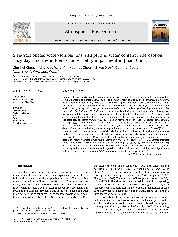摘要
To study the size-fractionated characteristics of aerosol chemical compounds including major water-soluble inorganic and organic ions, situ pH and water content as well as their influences on visibility, field sample collections using a Micro Orifice Uniform Deposit Impactor (MOUDI) combined with simulations by Aerosol Inorganic Model (AIM) were conducted on hazy and clear days in Jinan. China from April, 2006 to January, 2007. Average concentrations of TSP, PM(10) and PM(1.8) on hazy days were found to be 1.49-5.13,1.54-5.48 and 1.30-5.48 times those on clear days during the sampling periods, indicating that particulate pollution was very serious on hazy days. Size distributions of mass, SO(4)(2-), NO(3)(-), formate and acetate were all bimodal with fine mode predominant on hazy days, demonstrating that fine particles and secondary pollutants were more easily formed on hazy days. The average total aerosol concentration of H(+) ([H(+)](total)), of which free H(+) concentration ([H(+)](ins)) inside aerosol accounted for 30%, was 2.36-4.21 times that in other cities in China and US. The [H(+)](ins) on hazy days was 2.43-13.11 times that on clear days and the estimated situ pH was mainly influenced by RH and mole ratios of [NH(4)(+)]/[SO(4)(2-)]. Size distributions of situ pH were unimodal peaked at 0.56 mu m on clear days in spring and autumn as well as on hazy days in autumn, while a trend of increasing was shown on hazy days in spring and summer. The normalized water content (NWC) was higher on hazy days in autumn and winter because of the easier uptake of water by aerosol. It was found that when NWC < 2, if [NH4+]/[SO(4)(2-)] < 2.0, aerosol chemical components were more sensitive to water content, while if [NH(4)(+)]/[SO(4)(2-)] > 2.0, relative humidity (RH) was more important. Size distributions of water content showed a trend of sharp increasing on hazy days in spring and autumn. Correlation and regression analysis indicated that visibility was significantly influenced by the concentrations of SO(4)(2-) and water content in the range of 1.0-1.8 mu m.
